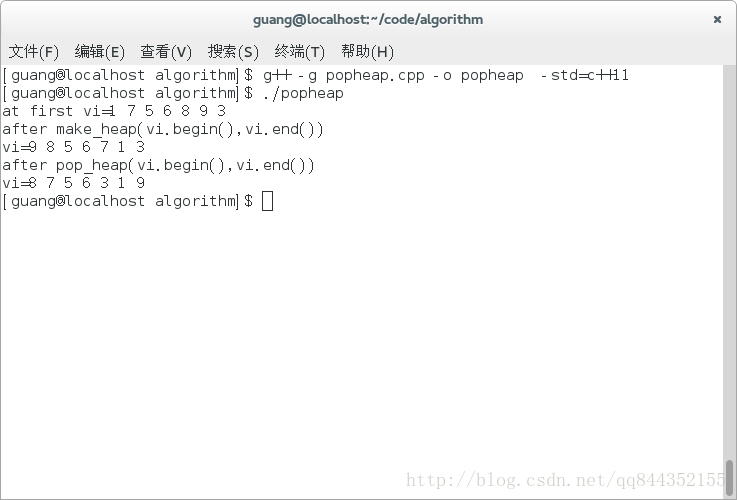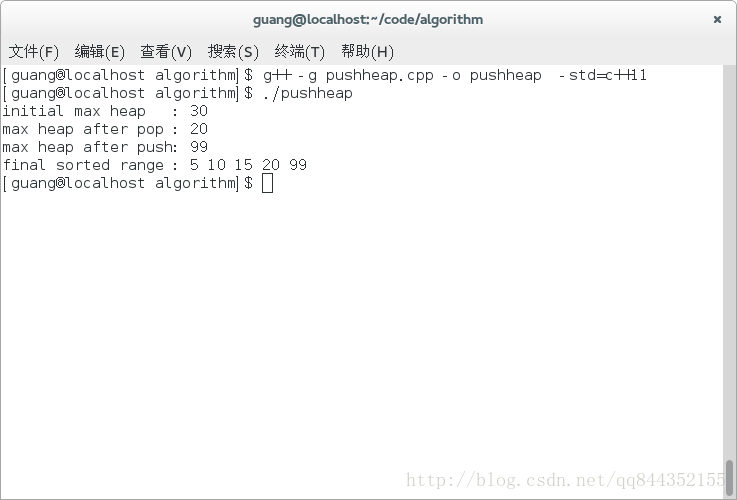我是靠谱客的博主 糟糕黑猫,最近开发中收集的这篇文章主要介绍STL algorithm算法pop_heap,push_heap(45) std::pop_heap std::push_heap,觉得挺不错的,现在分享给大家,希望可以做个参考。
概述
pop_heap原型:
std::pop_heap
| default (1) | template <class RandomAccessIterator>
void pop_heap (RandomAccessIterator first, RandomAccessIterator last);
|
|---|---|
| custom (2) | template <class RandomAccessIterator, class Compare>
void pop_heap (RandomAccessIterator first, RandomAccessIterator last,
Compare comp); |
调用该方法后,范围内的元素依旧保持堆的属性。
一个简单的例子:
#include <iostream>
#include <algorithm>
#include <vector>
using namespace std;
int main(){
vector<int> vi{1,7,5,6,8,9,3};
cout<<"at first vi=";
for(int i:vi)
cout<<i<<" ";
cout<<endl;
make_heap(vi.begin(),vi.end());
cout<<"after make_heap(vi.begin(),vi.end())nvi=";
for(int i:vi)
cout<<i<<" ";
cout<<endl;
pop_heap(vi.begin(),vi.end());
cout<<"after pop_heap(vi.begin(),vi.end())"<<endl;
cout<<"vi=";
for(int i:vi)
cout<<i<<" ";
cout<<endl;
} 
可以看到,9依旧保留在原范围的last-1位置。如果需要,需要手动删除。
除此之外,前面的元素依旧以堆的形式存放。
push_heap原型:
std::push_heap
| default (1) | template <class RandomAccessIterator>
void push_heap (RandomAccessIterator first, RandomAccessIterator last);
|
|---|---|
| custom (2) | template <class RandomAccessIterator, class Compare>
void push_heap (RandomAccessIterator first, RandomAccessIterator last,
Compare comp); |
这句话有点拗口。
看一个例子就很容易明白了。
// range heap example
#include <iostream> // std::cout
#include <algorithm> // std::make_heap, std::pop_heap, std::push_heap, std::sort_heap
#include <vector> // std::vector
int main () {
int myints[] = {10,20,30,5,15};
std::vector<int> v(myints,myints+5);
std::make_heap (v.begin(),v.end());
std::cout << "initial max heap : " << v.front() << 'n';
std::pop_heap (v.begin(),v.end()); v.pop_back();
std::cout << "max heap after pop : " << v.front() << 'n';
v.push_back(99); std::push_heap (v.begin(),v.end());
std::cout << "max heap after push: " << v.front() << 'n';
std::sort_heap (v.begin(),v.end());
std::cout << "final sorted range :";
for (unsigned i=0; i<v.size(); i++)
std::cout << ' ' << v[i];
std::cout << 'n';
return 0;
}
仔细看这一句:
v.push_back(99); std::push_heap (v.begin(),v.end());也就是说,先将要插入的元素插入到序列的最后,然后再插入到堆中!
——————————————————————————————————————————————————————————————————
//写的错误或者不好的地方请多多指导,可以在下面留言或者点击左上方邮件地址给我发邮件,指出我的错误以及不足,以便我修改,更好的分享给大家,谢谢。
转载请注明出处:http://blog.csdn.net/qq844352155
author:天下无双
Email:coderguang@gmail.com
2014-9-22
于GDUT
——————————————————————————————————————————————————————————————————
最后
以上就是糟糕黑猫为你收集整理的STL algorithm算法pop_heap,push_heap(45) std::pop_heap std::push_heap的全部内容,希望文章能够帮你解决STL algorithm算法pop_heap,push_heap(45) std::pop_heap std::push_heap所遇到的程序开发问题。
如果觉得靠谱客网站的内容还不错,欢迎将靠谱客网站推荐给程序员好友。
本图文内容来源于网友提供,作为学习参考使用,或来自网络收集整理,版权属于原作者所有。








发表评论 取消回复